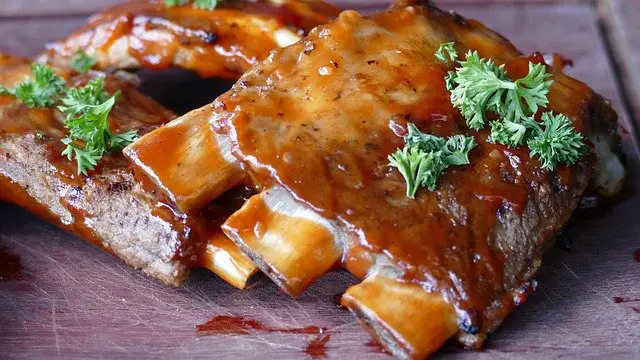This post contains affiliate links. I may receive a commission for qualifying purchases. See my affiliate disclaimer for details.
Southern cuisine and barbecued ribs go together like peanut butter and jelly. But a big question many newbies to this backyard delicacy is which ribs are best pork or beef? In this post, I will share some facts about pork ribs and beef ribs and let you be the judge of the ones you prefer.
How do you pick the best ribs?
Choose slabs that have a fair amount of flesh covering the bones and no big amounts of surface fat. Avoid “shiners,” which are slabs with the meat cut too near to the bone. During cooking, these exposed bones may come out.
If at all possible, avoid buying ribs that are frozen or have already been frozen. This isn’t always possible, and it’s sometimes impossible to tell if the ribs have been frozen before.
In fact, some people believe there isn’t much of a difference in quality between fresh and frozen ribs when it comes to the completed result. However, if you have a choice, I believe that fresh is the best option.
Should I buy beef or pork ribs?

Beef ribs are often thicker and fatter than pork ribs. Pork ribs, on the other hand, are more versatile due to their softer flavor due to the decreased fat level. Pork ribs are also easier to come by in bulk and take less time to make.
Which is healthier pork ribs or beef ribs?
Pork or beef ribs are the most common choices. When cooked properly, both are tasty and juicy, but pork is the leaner alternative.
Baby back or spare ribs are the most prevalent cuts of pork ribs. Spare ribs have more meat, but they also have more fat and calories. They’re also oddly shaped, making it difficult to cook them evenly. They’re frequently sold “St. Louis Style” cut to make the rack of ribs easier to handle.
Overall, baby backs have the lowest fat and calorie content, as well as being more tender and quick to cook.
What’s the difference in pork ribs and beef ribs?
As you well know, beef ribs and pork ribs are both meat cuts. The primary difference is that pork ribs are made from the rib cage of a pig, whereas beef ribs are made from the rib cage of a cow. Pork ribs are much smaller than beef ribs. As a result, beef ribs are often more meaty than pig ribs and chewier than pork spare ribs.
So, which ribs are best pork or beef?
Nutritional differences
The difference in fat content between beef and pig ribs, as well as the amount of meat in general, has an impact on the nutritional value of the two.
When compared to pork ribs, beef ribs will be more satisfying due to their higher calorie count, higher protein content, and higher iron content.
Pork baby back ribs
Pork ribs are made from the pig’s back and frequently include loin meat.
A serving of baby back ribs provides 243 calories, 19.56 grams of protein, 18.28 grams of fat, and 71 milligrams of cholesterol in a 3 ounce (85 gram) portion.
They contain 39 milligrams calcium, 14 milligrams magnesium, 140 milligrams phosphorus, 204 milligrams potassium, 80 milligrams sodium, 2.61 milligrams zinc, 27.4 micrograms selenium, and trace amounts of iron, copper, and manganese are included in the mineral composition. Niacin is 6.5 milligrams, pantothenic acid is 1.07 milligrams, choline is 66.8 milligrams, vitamin A is 17 IU, vitamin D is 41 IU, and thiamine, riboflavin, vitamin B-6, vitamin B-12, and vitamin E are trace amounts.
Beef ribs
Country-style ribs are actually meat pieces from various parts of the cow, rather than ribs. The chuck, cross rib, bottom round, and flatiron parts of the cow are used to make country-style ribs. They’re usually boneless and packed with protein.
A serving of country-style ribs provides 252 calories, 23.5 grams of protein, 17.5 grams of fat, and 82 milligrams of cholesterol in a 3 ounce (85 gram) portion.
They contain 4 milligrams calcium, 2.1 milligrams iron, 14 milligrams magnesium, 146 milligrams phosphorus, 210 milligrams potassium, 55 milligrams sodium, 7.57 milligrams zinc, 26.1 micrograms selenium, and trace levels of copper and manganese are all present in the mineral composition. 3.2 milligrams niacin, 6 micrograms folate, 75.5 milligrams choline, 2.63 micrograms vitamin B-12, 23 IU vitamin A, 5 IU vitamin D, 1.4 micrograms vitamin K, and trace amounts of vitamins E, B-6, pantothenic acid, riboflavin, and thiamine are among the vitamins.
Conclusion
When it comes to pig ribs vs. beef ribs, it’s difficult to say if one is necessarily superior to the other. At the end of the day, it all boils down to personal preference. Both are excellent choices for a delectable piece of meat that smokes well and feeds a crowd.
The true answer will be highly subjective. Pork ribs have a different flavor and texture than beef ribs, which some people prefer. While others may have the opposite opinion. It all comes down to your personal preferences and those of the people you’re cooking for.
In comparison to pork ribs, beef ribs, like other fine cuts of beef, have a strong characteristic flavor that requires little more than salt and pepper to bring out (and sometimes garlic).
Pork ribs, on the other hand, do not have the same robust flavor as beef ribs. It’s even been described as mildly sweet by some. Pork ribs can taste a lot like pork chops if they aren’t seasoned properly. Pork ribs, on the other hand, can be paired with a wide range of spices, rubs, and barbecue sauces.






